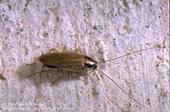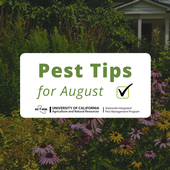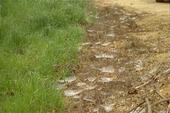
Nobody wants cockroaches in their home, especially since these pests can cause and worsen allergies in children, transmit diseases and bacteria, and contaminate foods.
If you find cockroaches in or around your home, do you reach for a do-it-yourself spray product? Well, you might not want to waste your money!
New research shows that some common consumer-grade insecticide sprays don't work to get rid of cockroach infestations. The study focused on products containing pyrethroids, which is a group of pesticides commonly found in many household insecticide products. Examples of...

Fleas can be found on pets year-round, but populations tend to increase dramatically in spring and summer when temperatures are warmer. Larvae develop rapidly in areas where temperatures reach 70° to 90°F. Fleas are a major concern for pet owners as they can give dogs and cats tapeworms, but they can also transmit flea-borne typhus to people and spread plague to wild animals like ground squirrels. These blood-sucking pests can be introduced to backyards from feral cats, squirrels, opossums, and other wildlife.
To learn more about fleas, the diseases they can spread, and their management, check out the recording of UC IPM's Urban & Community IPM Webinar from June 2024 at

Summer is in full swing and while it's been quite hot in many parts of California, it's been very cool in others. That's why UC IPM's Seasonal Landscape IPM Checklist is a useful tool to help you figure out what to do in your region each month!
Here are some general tips for the month of August to prevent pests and their damage in the garden and landscape. Visit the tool to see more pest management to-dos in your region.
- Manage ants around landscapes and building foundations using insecticide baits and trunk barriers.
- Prune off...
- Author: Lauren Fordyce

Are you noticing an abundance of cobwebs outside, on plants, fences, homes, or outdoor furniture?
While many people fear spiders or dislike their cobwebs, most spiders are beneficial to have around– even in the home! Spiders are predators of many insect pests and rarely cause harm to people. The only medically significant spiders in California are brown and black widows. While these spiders have the potential to cause harm, it is rare that they will bite, even in areas where they are very common. Like most spiders, they prefer to stay hidden and avoid people.
Some common web-spinning spiders you might encounter outdoors...
- Author: National Pesticide Information Center (NPIC)

Acetic acid, also known as vinegar, is used in products for weed control. Many people choose it because it is natural. However, acetic acid can damage skin and eyes, especially at concentrations commonly found in weed killers.
What is the difference between acetic acid, vinegar, and horticultural vinegar?
You may know acetic acid best as vinegar. Vinegar is a solution of acetic acid in water. Acetic acid is a naturally occurring substance that is found in all living things. It is formed during fermentation. Acetic acid can also be made industrially. It is used in many industrial processes, including the manufacture of dyes, plastics, some drugs, and other industrial chemicals. It is also used in textile...


